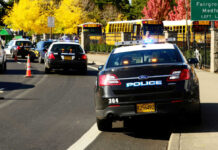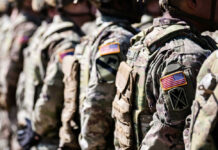
(RightWingJournal.com) – Two Miami police officers were shot on a quiet October morning, setting off an urban standoff that would test the limits of law enforcement, the patience of a neighborhood, and the thin line between chaos and control.
Story Snapshot
- Two officers wounded during a response in Miami’s Allapattah neighborhood
- Suspect barricaded himself, prompting a massive police and SWAT response
- Negotiations intensified as family and tactical teams worked for resolution
- Incident spotlights the persistent risks and evolving tactics in urban policing
Shots Fired, Streets Locked Down: The Scene in Allapattah
Gunfire shattered the uneasy dawn in Miami’s Allapattah neighborhood on October 9, 2025. Police responding to a car found “riddled with bullets” quickly found themselves under direct attack. Two City of Miami officers, both veterans of urban policing, were wounded, one struck in the knee, the other in the ankle. The suspect, undeterred and dangerous, retreated into a nearby house, igniting a standoff that would paralyze several city blocks and draw the gaze of a tense city.
Within minutes, SWAT teams and tactical units flooded the area. Police cordoned off streets from 14th to 18th on 10th Avenue, forming a tight perimeter amid the chaos. The cordons trapped residents, forced businesses to shutter, and left a community suspended in a moment of palpable anxiety. The standoff was not a momentary blip but an unfolding drama, shaped by the decisions of negotiators, the pleas of family members, and the measured caution of incident commanders.
Why Miami’s Barricade Standoffs Are Different
Miami has long been a city where routine police calls can spiral into life-or-death struggles. Allapattah’s dense streets and history of violent confrontation create a unique pressure cooker effect. The morning’s events were not isolated; recent months had seen a spike in gun violence, with officers increasingly encountering armed resistance even on calls that begin as simple crime scene investigations.
The suspect’s decision to barricade himself wasn’t new, but the response was a product of hard-earned lessons from past Miami crises. SWAT deployment, negotiation teams, and even bringing in family to communicate with the suspect underscored a modern approach to law enforcement, one that balances overwhelming force with the art of de-escalation. Every move was calculated: keep the public and officers safe, resolve the standoff peacefully if possible, and avoid turning a neighborhood into a war zone.
The Human Stakes: Officers, Residents, and a Community on Edge
For the wounded officers, the day became a test of resilience and training. Rushed to Jackson Memorial Hospital, they were treated for injuries deemed non-life-threatening, a rare stroke of fortune in a morning filled with lethal risk. Their families, like so many in blue, waited for updates, their relief mingled with the ever-present worry that next time, Miami might not be so lucky.
Residents of Allapattah bore a different burden. Suddenly cordoned in, they watched armored vehicles roll past their homes and heard the negotiation attempts echoing down narrow streets. The ripple effects hit local businesses and deepened the sense of vulnerability in a neighborhood already marked by periodic spikes in violence. Tensions ran high, but so did the hope that this would end without more bloodshed.
Negotiation, Patience, and the Tactical Calculus
The standoff unfolded with methodical intensity. Police negotiators worked the phones and loudhailers, at times enlisting the suspect’s family to break through the barricade of fear and desperation inside the house. Incident commanders, guided by experience and public scrutiny, refused to rush. Every hour that passed underscored the delicate balance between swift action and patient negotiation.
This was not just a test of tactical prowess but of community trust. Police walked a tightrope, aware that every decision would be judged by the outcome, by whether Miami saw a peaceful surrender or another tragedy. The Chief’s statements reinforced the focus on safety, signaling a shift in priorities from brute force toward a more nuanced, human-centered approach to crisis resolution.
Aftermath and the Questions That Remain
By afternoon, the standoff was ongoing, with negotiators and tactical teams maintaining their posts as the city watched and waited. The incident would leave scars, on the officers, on the suspect’s family, and on a neighborhood once again thrust into the spotlight. It would also reignite debates over police tactics, community relations, and the relentless risks of urban policing.
The story of that October morning in Allapattah is one of split-second danger and hours of waiting, of bullets and barricades, of human frailty and institutional resolve. It posed questions that Miami, and cities like it, must keep asking: How do we keep officers and civilians safe when the streets erupt? What does it take to end violence without more loss? And, most of all, what does it mean when a “routine” call becomes a defining moment for an entire community?
Copyright 2025, rightwingjournal.com





























